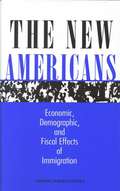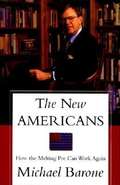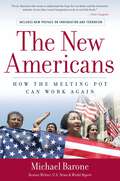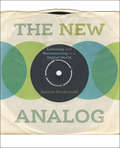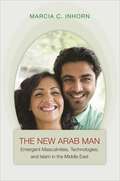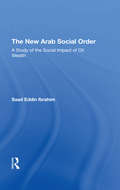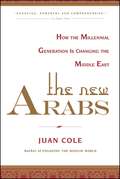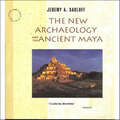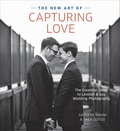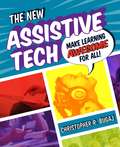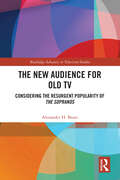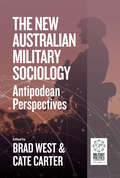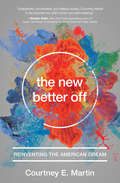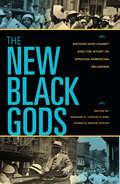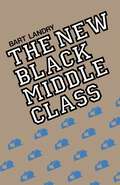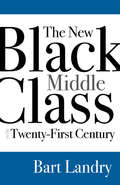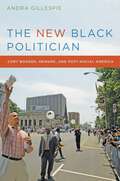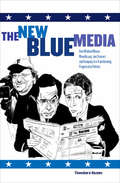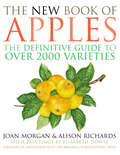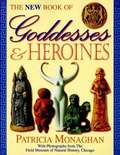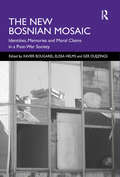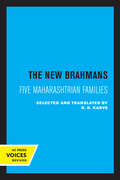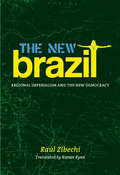- Table View
- List View
The New Americans: A Guide to Immigration since 1965 (Harvard University Press Reference Library #2)
by Helen B. Marrow Mary C. Waters Reed UedaListen to a short interview with Mary Waters Host: Chris Gondek | Producer: Heron & Crane Salsa has replaced ketchup as the most popular condiment. A mosque has been erected around the corner. The local hospital is staffed by Indian doctors and Philippine nurses, and the local grocery store is owned by a Korean family. A single elementary school may include students who speak dozens of different languages at home. This is a snapshot of America at the turn of the twenty-first century. The United States has always been a nation of immigrants, shaped by successive waves of new arrivals. The most recent transformation began when immigration laws and policies changed significantly in 1965, admitting migrants from around the globe in new numbers and with widely varying backgrounds and aspirations. This comprehensive guide, edited and written by an interdisciplinary group of prominent scholars, provides an authoritative account of the most recent surge of immigrants. Twenty thematic essays address such topics as immigration law and policy, refugees, unauthorized migrants, racial and ethnic identity, assimilation, nationalization, economy, politics, religion, education, and family relations. These are followed by comprehensive articles on immigration from the thirty most significant nations or regions of origin. Based on the latest U.S. Census data and the most recent scholarly research, The New Americans is an essential reference for students, scholars, and anyone curious about the changing face of America.
The New Americans: Economic, Demographic, and Fiscal Effects of Immigration
by Panel on the Demographic Economic Impacts of ImmigrationThis book sheds light on one of the most controversial issues of the decade. It identifies the economic gains and losses from immigration--for the nation, states, and local areas--and provides a foundation for public discussion and policymaking. Three key questions are explored: What is the influence of immigration on the overall economy, especially national and regional labor markets? What are the overall effects of immigration on federal, state, and local government budgets? What effects will immigration have on the future size and makeup of the nation's population over the next 50 years? The New Americans examines what immigrants gain by coming to the United States and what they contribute to the country, the skills of immigrants and those of native-born Americans, the experiences of immigrant women and other groups, and much more. It offers examples of how to measure the impact of immigration on government revenues and expenditures--estimating one year's fiscal impact in California, New Jersey, and the United States and projecting the long-run fiscal effects on government revenues and expenditures. Also included is background information on immigration policies and practices and data on where immigrants come from, what they do in America, and how they will change the nation's social fabric in the decades to come.
The New Americans: How the Melting Pot Can Work Again
by Michael BaroneSometime in this century, we are told, the United States will become a "majority-minority" country-that is, a nation where whites make up less than 50 percent of the population. Many believe this signals a fundamental change in America. Does it? Is the Melting Pot a thing of the past? Absolutely not, says political historian Michael Barone. He uses this book to remind us that the United States has never been a homogeneous, monoethnic nation. He reveals how the new Americans today can be interwoven into the fabric of American life just as immigrants have been interwoven throughout U.S. history.
The New Americans: How the Melting Pot Can Work Again
by Michael BaroneSometime in this century, we are told, the United States will become a "majority-minority" country--that is, a nation where whites make up less than 50 percent of the population. Many believe this signals a fundamental change in America. Does it? Is the Melting Pot a thing of the past?Absolutely not, says political historian Michael Barone. In The New Americans, Barone reminds us that the United States has never been a homogeneous, monoethnic nation. He reveals how the new Americans of today can be interwoven into the fabric of American life just as immigrants have been interwoven throughout U.S. history.If we heed the lessons of America's past--and avoid misguided policies and programs that hinder rather than help assimilation--the Melting Pot can work as well today as it always has.
The New Analog: Listening and Reconnecting in a Digital World
by Damon KrukowskiAn NPR Best Book of the Year: &“A pointedly passionate look at what&’s been lost in the digital era.&” —Los Angeles Times A longtime musician and former member of the indie band Galaxie 500 who has also taught at Harvard, Damon Krukowski has watched cultural life lurch from analog to digital. And as an artist who has weathered that transition, he has challenging, urgent questions for both creators and consumers about what we have thrown away in the process: Are our devices leaving us lost in our own headspace even as they pinpoint our location? Does the long reach of digital communication come at the sacrifice of our ability to gauge social distance? Does streaming media discourage us from listening closely? Are we hearing each other fully in this new environment? Rather than simply rejecting the digital disruption of cultural life, Krukowski uses the sound engineer&’s distinction of signal and noise to reexamine what we have lost as a technological culture, looking carefully at what was valuable in the analog realm so we can hold on to it. Taking a set of experiences from the production and consumption of music that have changed since the analog era—the disorientation of headphones, flattening of the voice, silence of media, loudness of mastering, and manipulation of time—as a basis for a broader exploration of contemporary culture, Krukowski gives us a brilliant meditation and guide to keeping our heads amid the digital flux. Think of it as plugging in without tuning out. &“This is not a book about why vinyl sounds better; it&’s way more interesting than that . . . [It] is full of things I didn&’t know, like why people yell into cellphones . . . Ultimately, it&’s about how we consume sound as a society—which is, increasingly, on an individual basis.&” —NPR &“If you&’re a devoted music fan who&’s dubious about both rosy nostalgia and futuristic utopianism, Damon Krukowski&’s The New Analog is for you.&” —The New York Times Book Review
The New Arab Man: Emergent Masculinities, Technologies, and Islam in the Middle East
by Marcia C. InhornMiddle Eastern Muslim men have been widely vilified as terrorists, religious zealots, and brutal oppressors of women. The New Arab Man challenges these stereotypes with the stories of ordinary Middle Eastern men as they struggle to overcome infertility and childlessness through assisted reproduction. Drawing on two decades of ethnographic research across the Middle East with hundreds of men from a variety of social and religious backgrounds, Marcia Inhorn shows how the new Arab man is self-consciously rethinking the patriarchal masculinity of his forefathers and unseating received wisdoms. This is especially true in childless Middle Eastern marriages where, contrary to popular belief, infertility is more common among men than women. Inhorn captures the marital, moral, and material commitments of couples undergoing assisted reproduction, revealing how new technologies are transforming their lives and religious sensibilities. And she looks at the changing manhood of husbands who undertake transnational "egg quests"--set against the backdrop of war and economic uncertainty--out of devotion to the infertile wives they love. Trenchant and emotionally gripping, The New Arab Man traces the emergence of new masculinities in the Middle East in the era of biotechnology.
The New Arab Social Order: A Study Of The Social Impact Of Oil Wealth
by Saad E. IbrahimThe skyrocketing Arab oil revenues of the 1970s have triggered tremendous socioeconomic forces in the Arab world. Observers have extensively studied the financial and geopolitical aspects of Arab oil, but generally have ignored the human and social repercussions stimulated by the oil wealth. This book challenges the commonly accepted view of the im
The New Arabs: How the Millennial Generation is Changing the Middle East
by Juan ColeRenowned blogger and Middle East expert Juan Cole takes us “inside the youth movements in Tunisia, Egypt, and Libya, showing us how activists used technology and social media to amplify their message and connect with like-minded citizens” (The New York Times) in this “rousing study of the Arab Spring” (Publishers Weekly, starred review).<P><P> For three decades, Cole has sought to put the relationship of the West and the Muslim world in historical context. In The New Arabs he has written “an elegant, carefully delineated synthesis of the complicated, intertwined facets of the Arab uprisings,” (Kirkus Reviews), illuminating the role of today’s Arab youth—who they are, what they want, and how they will affect world politics.<P> Not all big groups of teenagers and twenty-somethings necessarily produce historical movements centered on their identity as youth, with a generational set of organizations, symbols, and demands rooted at least partially in the distinctive problems of people their age. The Arab Millennials did. And, in a provocative, big-picture argument about the future of the Arab world, The New Arabs shows just how they did it. “Engaging, powerful, and comprehensive…The book feels as indispensable to scholars as it is insightful for a more casual reader” (Los Angeles Times).
The New Archaeology and the Ancient Maya
by Jeremy A. SabloffNowadays, archaeological investigators don't just dig up the pastThey use high-tech equipment, chemical analyses, sampling strategies, and other modern means to gain a better understanding of why and how cultures change. Using the study of the Maya as a test case, Jeremy Sabloff shows how the exciting transformation of archaeology is shedding new light on past civilizations.
The New Art History: A Critical Introduction
by Jonathan HarrisThe New Art History provides a comprehensive introduction to the fundamental changes which have occurred in both the institutions and practice of art history over the last thirty years. Jonathan Harris examines and accounts for the new approaches to the study of art which have been grouped loosely under the term 'the new art history'. He distinguishes between these and earlier forms of 'radical' or 'critical' analysis, explores the influence of other disciplines and traditions on art history, and relates art historical ideas and values to social change. Structured around an examination of key texts by major contemporary critics, including Tim Clarke, Griselda Pollock, Fred Orton, Albert Boime, Alan Wallach and Laura Mulvey, each chapter discusses a key moment in the discipline of art history, tracing the development and interaction of Marxist, feminist and psychoanalytic critical theories. Individual chapters include: * Capitalist Modernity, the Nation-State and Visual Representation * Feminism, Art, and Art History * Subjects, Identities and Visual Ideology * Structures and Meanings in Art and Society * The Representation of Sexuality
The New Art of Capturing Love
by Thea Dodds Kathryn HammThe first guide to posing and sensitively capturing same-sex couples on their big day, The New Art of Capturing Love equips semi-pro and professional wedding photographers to enter the exciting new LGBT wedding photography market.With nearly half of the states in the US (and 13 countries) currently recognizing same-sex partnerships, the market for LGBT weddings is poised for explosive growth, offering great opportunity for today's wedding photographers. But capturing portraits in this new market requires a new approach to posing, which until now has been nearly exclusively oriented toward pairing a larger man in black with a smaller woman in white. What works for Jack and Jill won't necessarily work for Jack and Michael, let alone Jill and Louise. The New Art of Capturing Loverewrites these traditional techniques, giving photographers the tools to create flattering, emotion-filled images for any couple in today's dynamic wedding market.
The New Assistive Tech: Make Learning Awesome For All!
by Christopher BurgajSchool districts often struggle to develop consistent practices for meeting the assistive needs of special education students. This playful yet professional book will help public school educators select, acquire and implement technology to help all students, but especially those with special needs. The New Assistive Tech is a catalyst for breaking down walls between special education and general education, and will help all educators realize they have tech knowledge (and can build upon that knowledge) that can be used to support students with disabilities. <p><p> This book: details how an educational team can request assistance to determine technology needs; explains how to conduct and document assessments to help an educational team make informed decisions about technology needs; describes a proactive approach to professional development for individuals and for those who train others on the use of technology; assists individuals or teams in creating an action plan for developing a culture of inclusion; and interweaves stories, songs and other exciting features to make learning fun!
The New Audience for Old TV: Considering the Resurgent Popularity of The Sopranos (Routledge Advances in Television Studies)
by Alexander H. BeareIn 2020-21, the classic HBO show The Sopranos (1999-2007) saw a rapid increase in viewership and was proclaimed to be one of the “hottest shows of lockdown” by outlets like The Guardian and GQ. This resurgent popularity of The Sopranos raises important analytical questions for media scholars—how do audiences understand a complex text like The Sopranos in a radically different televisual and cultural context? Did they adapt the show to fit the particularities of the present moment or was it simply a nostalgic escape from the bleak conditions of the pandemic? Perhaps most importantly though, did the distinct televisual environment of the 2020s bring with it markedly new ways for audiences to understand ‘old’ shows?The New Audience for Old TV is the first book to investigate how audiences re-read and re-interpret resurgent shows when watching in new cultural contexts. Based on a series of original research interviews with young fans, it considers how new contexts of interpretation, including the COVID-19 pandemic, Subscription Video on Demand (SVOD), and post #MeToo gender politics, informed the unique experience of watching. Using the metaphor of the anamorphic painting, it introduces the analytical framework of a ‘retrospective reading’ to reveal the new meanings that are being made available for ‘old’ TV.Ultimately, The New Audience for Old TV uncovers fresh insights into audiences’ experiences with ‘prestige’ TV and the new avenues of meaning-making in the age of streaming.
The New Australian Military Sociology: Antipodean perspectives (Military Politics #2)
by Brad West Cate CarterCivil-military relations have changed over time with respect to changing demographics, new domestic and international responsibilities, Industry-Defence cooperation, women in the armed forces and contemporary veteran wellbeing.The New Australian Military Sociology aims to provide an antipodean view to theorising civil-military entanglements and uses Australia’s unique geographic, political and cultural context to serve as a case study for other countries.
The New Better Off: Reinventing the American Dream
by Courtney E. MartinAre we living the good life-and what defines 'good', anyway? Americans today are constructing a completely different framework for success than their parents' generation, using new metrics that TEDWomen speaker and columnist Courtney Martin has termed collectively the "New Better Off". The New Better Off puts a name to the American phenomenon of rejecting the traditional dream of a 9-to-5 job, home ownership, and a nuclear family structure-illuminating the alternate ways Americans are seeking happiness and success.Including commentary on recent changes in how we view work, customs and community, marriage, rituals, money, living arrangements, and spirituality, The New Better Off uses personal stories and social analysis to explore the trends shaping our country today. Martin covers growing topics such as freelancing, collaborative consumption, communal living, and the breaking down of gender roles. The New Better Off is about the creative choices individuals are making in their vocational and personal lives, but it’s also about the movements, formal and informal, that are coalescing around the New Better Off idea-people who are reinventing the social safety net and figuring out how to truly better their own communities.
The New Black Gods: Arthur Huff Fauset and the Study of African American Religions
by Edward E. Curtis IV and Danielle Brune SiglerTaking the influential work of Arthur Huff Fauset as a starting point to break down the false dichotomy that exists between mainstream and marginal, a new generation of scholars offers fresh ideas for understanding the religious expressions of African Americans in the United States. Fauset's 1944 classic, Black Gods of the Metropolis, launched original methods and theories for thinking about African American religions as modern, cosmopolitan, and democratic. The essays in this collection show the diversity of African American religion in the wake of the Great Migration and consider the full field of African American religion from Pentecostalism to Black Judaism, Black Islam, and Father Divine's Peace Mission Movement. As a whole, they create a dynamic, humanistic, and thoroughly interdisciplinary understanding of African American religious history and life. This book is essential reading for anyone who studies the African American experience.
The New Black Middle Class
by Bart LandryIn this important new book, Bart Landry contributes significantly to the study of black American life and its social stratification and to the study of American middle class life in general.
The New Black Middle Class in the Twenty-First Century
by Bart LandryAlthough past research on the African American community has focused primarily on issues of discrimination, segregation, and other forms of deprivation, there has always been some recognition of class diversity within the black population. The New Black Middle Class in the Twenty-First Century is a significant contribution to the continuing study of black middle class life. Sociologist Bart Landry examines the changes that have occurred since the publication of his now-classic The New Black Middle Class in the late 1980s, and conducts a comprehensive examination of black middle class American life in the early decades of the twenty-first century. Landry investigates the educational and occupational attainment, income and wealth, methods of child-rearing, community-building priorities, and residential settlement patterns of this growing yet still-understudied segment of the U.S. population.
The New Black Politician: Cory Booker, Newark, and Post-Racial America
by Andra GillespieExplores young black politicians' pursuit of diverse constituenciesAt the beginning of the 21st-century, a vanguard of young, affluent black leadership has emerged, often clashing with older generations of black leadership for power. The 2002 Newark mayoral race, which featured a contentious battle between the young black challenger Cory Booker and the more established black incumbent Sharpe James, was one of a series of contests in which young, well-educated, moderate black politicians challenged civil rights veterans for power. In The New Black Politician, Andra Gillespie uses Newark as a case study to explain the breakdown of racial unity in black politics, describing how black political entrepreneurs build the political alliances that allow them to be more diversely established with the electorate. Based on rich ethnographic data from six years of intense and ongoing research, Gillespie shows that while both poor and affluent blacks pay lip service to racial cohesion and to continuing the goals of the Civil Rights Movement, the reality is that both groups harbor different visions of how to achieve those goals and what those goals will look like once achieved. This, she argues, leads to class conflict and a very public breakdown in black political unity, providing further evidence of the futility of identifying a single cadre of leadership for black communities. Full of provocative interviews with many of the key players in Newark, including Cory Booker himself, this book provides an on the ground understanding of contemporary Black and mayoral politics.
The New Blue Media: How Michael Moore, MoveOn.org, Jon Stewart and Company Are Transforming Progressive Politics
by Theodore HammA look at the journalists and satirists who&’ve helped transform the political landscape in the twenty-first century. The New Blue Media traces the rise during the Bush years of new media stars: the news-saturated satire of The Onion, The Daily Show, and The Colbert Report; the polemical assaults of Michael Moore and Air America; and the instant-messaging politics of MoveOn, Daily Kos, and the netroots. With the exception of Air America, all of these new media outlets have found commercial success—marking, says Hamm, a new era in liberal politics. Does this new media matter? In 2004, both Michael Moore and MoveOn became major players; more recently, the influence of the netroots has sparked upheaval and debate within the Democratic Party. The New Blue Media examines this phenomenon in depth, and the reshaping of both the style and the substance of progressivism.
The New Book of Apples
by Joan MorganThis extraordinary book contains in one unique volume, the most wide-ranging history of apples ever written and a detailed survey of over 2,000 of the world's apple varieties. Beautifully illustrated with 32 exquisite colour paintings, the last edition of this book received many accolades and was quickly recognised as a classic. Complete with a fully revised directory covering all the varieties of apple to be found in the world's largest apple collection, The New Book of Apples includes full historical, geographical and botanical details as well as tasting notes on each type of apple. Exploring the role of apples in cooking, cider making, gardening, myth and medicine, this is an indispensable reference guide.
The New Book of Goddesses and Heroines
by Patricia MonaghanThis is the third edition of the book that is widely acclaimed as the most comprehensive collection of myths surrounding goddess culture. More than that, it is a work of praise of the feminine and a reclaiming of that rich cultural history mostly suppressed by patriarchy.
The New Bosnian Mosaic: Identities, Memories and Moral Claims in a Post-War Society
by Elissa HelmsSince the violent events of the Bosnian war and the revelations of ethnic cleansing that shocked the world in the early 1990s, Bosnia has become a metaphor for the new ethnic nationalisms, for the transformation of warfare in the post-Cold War era, and for new forms of peacekeeping and state-building. This book is unique in offering a re-examination of the Bosnian case with a 'bottom-up' perspective. It gathers together cultural anthropologists and other social scientists to consider the specificities of the Bosnian case. However, the book also raises broader questions: what are the consequences of internecine violence and how should societies attempt to overcome them? Are the uncertainties and the transformations of Bosnian post-war society due entirely to the war, or are they related to wider processes encompassing post-communist Europe as a whole? And are the difficulties experienced by international state-building operations mainly due to distinctive features of the local societies or are they due to the policies promoted by the international community itself?
The New Brahmans: Five Maharashtrian Families
by D.D. KarveThis title is part of UC Press's Voices Revived program, which commemorates University of California Press’s mission to seek out and cultivate the brightest minds and give them voice, reach, and impact. Drawing on a backlist dating to 1893, Voices Revived makes high-quality, peer-reviewed scholarship accessible once again using print-on-demand technology. This title was originally published in 1963.
The New Brazil
by Ramor Ryan Raúl ZibechiIn the midst of a rapidly shifting global economy, Brazil has emerged as a powerful new player on the geopolitical stage. Against all odds, the Latin American nation managed, in just three years, to repay a 2002 $15.5 billion IMF bailout loan thanks to aggressive economic restructuring and a series of alliances that have placed it at the center of political and economic power in the region.From the outside, Brazil is a poster child for neoliberal capitalism. Yet inside the country, the lives of the Brazilian people are still marked by vast inequities in wealth and access to social services--a striking disparity with the nation's newfound power in the global economy. In June of 2013, protests against the increasing costs of public transportation swelled to mass demonstrations against the Rousseff government's failure to address this disparity, leading many to wonder whether the popular movements in Brazil may be just powerful enough to shift the nation's influence towards a wholly new economic model based in regional integration.The New Brazil explores this disparity. Will the nation serve as the glue that holds together the Latin American states, distancing themselves from the neoliberalism of the United States and Canada? Or will Brazil simply become another world superpower, able to subject the rest of Latin American to its will? Only time will tell.Raul Zibechi is a journalist and social-movement analyst based in Montevideo, Uruguay. He is the author of numerous books including Dispersing Power and Territories in Resistance, both published by AK Press.

